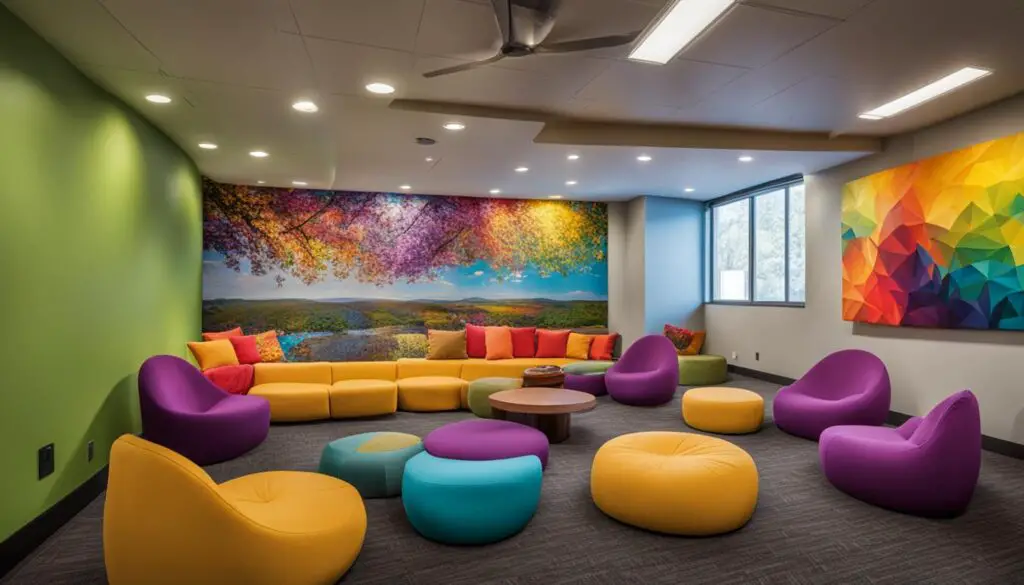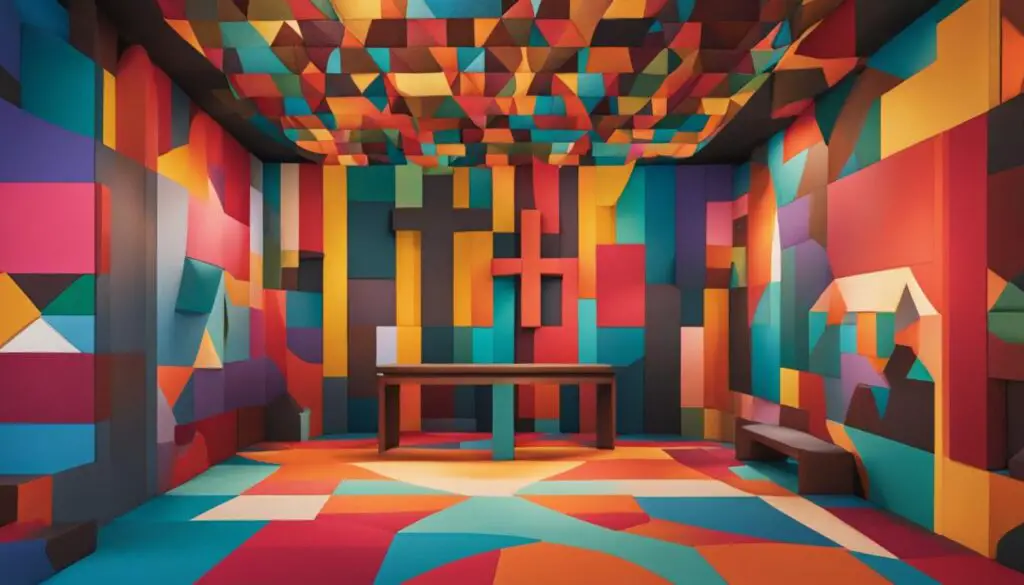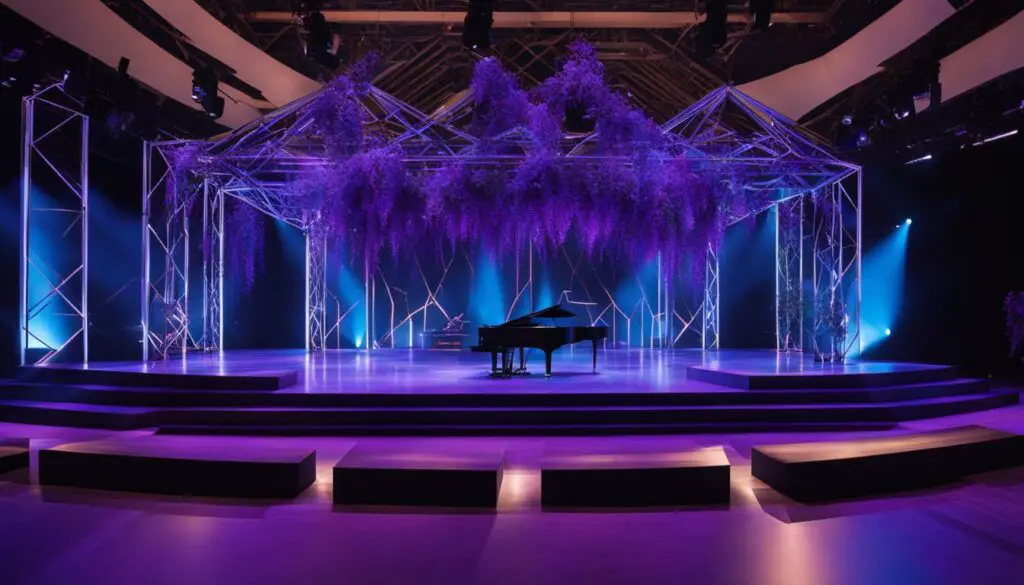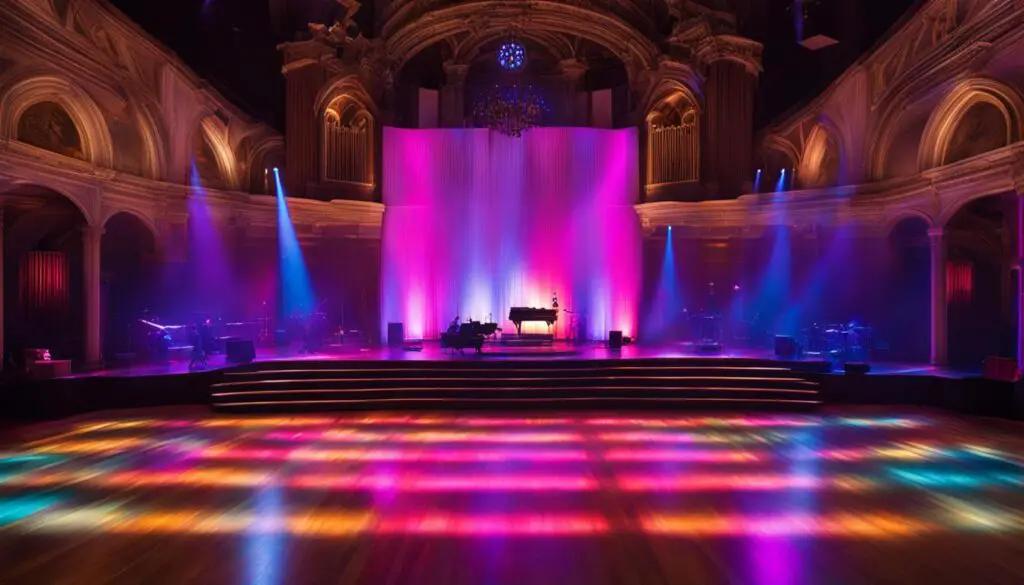Creating a welcoming and inspiring youth room is essential for engaging young people in their faith journey. With innovative designs and thoughtfully chosen decor, the church youth room can become a vibrant space that nurtures spiritual growth and fosters a sense of community. Let’s explore some creative church youth room designs, ideas, and decor that will inspire and uplift the hearts of the youth.
Key Takeaways:
- Church youth room designs play a vital role in engaging young people in their faith.
- By implementing creative designs, youth rooms can become vibrant and meaningful spaces.
- Aesthetics and decor in the youth room have a profound impact on youth development.
- The design of the youth room should align with the church’s theology and values.
- Involving young people in the design process fosters a sense of belonging and ownership.
The Impact of Aesthetics on Youth Development
Youth development is a holistic process that encompasses various aspects of a young person’s life. One often overlooked factor in this process is aesthetics. The design and aesthetics of a youth room can have a profound impact on young people’s overall development, including their spiritual growth, emotional well-being, and social engagement.
Research shows that aesthetics play a significant role in shaping our experiences and influencing our emotions. An aesthetically pleasing environment can evoke positive emotions, spark creativity, and enhance cognitive function. When it comes to youth development, creating a visually appealing and meaningful space can help foster a sense of belonging, inspiration, and connection with a higher power.
“The beauty of the space we inhabit can evoke a sense of awe and wonder, prompting us to reflect on the mysteries of life and explore our faith in a deeper way.”
The Power of Aesthetics in Holistic Formation
When young people are immersed in an environment that reflects beauty and meaning, it can have a transformative effect on their character development and moral formation. Aesthetics provide a visual language through which young people can explore their values, beliefs, and personal identity. By designing a youth room with intention and purpose, youth leaders can create a space that facilitates holistic formation and encourages young people to reflect on their faith journey.
The aesthetic choices made in the youth room can communicate the values and theology of the church. For example, incorporating symbols of hope, such as crosses or doves, can remind young people of the transformative power of faith. Thoughtfully selecting color schemes, lighting, and furnishings can create an atmosphere that invites contemplation, worship, and engagement with sacred texts.

| Aesthetics and Youth Development | Impacts |
|---|---|
| Engaging and meaningful design | Creates a sense of belonging and connection |
| A visually appealing space | Fosters inspiration and creativity |
| Thoughtful use of symbolism and lighting | Promotes contemplation and worship |
| Reflects church values and theology | Enhances spiritual growth and holistic formation |
By recognizing the impact of aesthetics on youth development and intentionally designing youth rooms that reflect beauty and meaning, churches can create spaces that inspire faith, foster holistic formation, and nurture the next generation of spiritual leaders.
The Theology of Space in Youth Ministry
In youth ministry, the design of church environments goes beyond aesthetics. It reflects theological commitments and communicates the values and meaning of the faith community. The theology of space emphasizes the importance of intentional design choices that align with the church’s theology and create a space that fosters growth and connection with God. Three key elements play a significant role in the theology of space: the arrangement of space, color schemes, and symbolism.
The Arrangement of Space

The physical layout of a youth room can shape the way young people interact with each other and engage in spiritual activities. Consider creating different zones within the room for various purposes, such as a quiet area for reflection, a gathering space for discussions, and an interactive area for group activities. By thoughtfully arranging the space, youth leaders can create an environment that encourages connection, collaboration, and personal growth.
Color Schemes and Lighting
The use of color schemes and lighting can evoke specific emotions and set the tone for worship and spiritual activities. Warm colors, like reds and yellows, can create a welcoming and energetic atmosphere, while cool colors, like blues and greens, can foster a sense of calm and introspection. Additionally, utilizing natural lighting or soft, warm lighting can enhance the overall ambiance of the youth room and create a space that feels inviting and peaceful.
Symbolism and Meaning
Symbols play a crucial role in communicating the church’s theology and values. Incorporating symbolic elements such as crosses, doves, or biblical imagery can reinforce the messages and themes of faith. These symbols remind young people of the significance of their spiritual journey and create a visual representation of their shared beliefs and experiences. By incorporating meaningful symbolism, the youth room becomes a sacred space where young people can connect with God and deepen their faith.
| Element | Importance |
|---|---|
| Arrangement of Space | The physical layout can encourage connection and personal growth. |
| Color Schemes and Lighting | Colors and lighting set the tone for worship and create a welcoming atmosphere. |
| Symbolism and Meaning | Incorporating symbols communicates the church’s theology and reinforces faith messages. |
Engaging Youth through Collaborative Design
One of the most effective ways to create an engaging and meaningful youth room is through collaborative design. Involving young people in the design process not only gives them a sense of ownership but also fosters a deeper sense of belonging within the ministry. When young people feel that their voices are heard and their ideas are valued, they become more invested in the space and are more likely to actively participate and engage in the activities and programs offered.
Collaborative design also allows for communal buy-in, where the entire youth community feels a sense of responsibility for the youth room. By working together to design and create the space, young people develop a stronger connection with one another as they collaborate, compromise, and problem-solve. This shared experience builds a sense of unity and camaraderie, creating a supportive and encouraging environment for spiritual growth.
“When young people have a say in the design of their youth room, it empowers them and gives them a sense of pride and ownership. It becomes a space that truly reflects their preferences and values, making them feel valued and understood.”
Collaborative design also provides an opportunity for youth leaders to teach and guide young people through the design process. It allows for meaningful discussions about the purpose and function of the space, as well as the aesthetic and symbolic choices that can enhance the spiritual atmosphere. Through this process, youth leaders can help young people develop critical thinking skills, artistic sensibilities, and a deeper understanding of the theology behind the design.
By engaging youth through collaborative design, churches can create youth rooms that not only inspire faith but also foster a sense of belonging and ownership among young people. It is a powerful tool for building community, encouraging active participation, and nurturing the spiritual growth of the next generation.

Practical Tips for Church Youth Room Design
When designing a church youth room, there are several practical considerations to take into account. The arrangement of furniture, the layout of the room, and the decoration choices can significantly impact the functionality and atmosphere of the space. By carefully planning and implementing these elements, you can create a youth room that is not only visually appealing but also conducive to gathering, prayer, worship, connection, reflection, and fun.
Furniture
Choosing the right furniture for your church youth room is essential for creating a comfortable and functional space. Opt for durable and versatile pieces that can accommodate various activities and group sizes. Consider incorporating movable furniture, such as stackable chairs and folding tables, to easily transform the space for different events. Additionally, ensure that there are enough seating options and storage solutions to keep the room organized and clutter-free.
Layout
The layout of the youth room should be designed with the flow of activities in mind. Create distinct zones or areas for different purposes, such as a seating area for discussions, a study corner, a game area, and a quiet space for reflection. Arrange the furniture and amenities in a way that promotes interaction, collaboration, and easy access. It’s also important to consider accessibility and ensure that the room is wheelchair-friendly.
Decoration
Decorating the youth room can make it more inviting and reflective of the church’s values. Choose decor elements that are age-appropriate and aligned with your desired atmosphere. Consider incorporating inspirational quotes, artwork, or religious symbols that resonate with young people. Use color schemes that evoke a sense of positivity, energy, or calmness, depending on the intended purpose of the space. By thoughtfully decorating the youth room, you can create an environment that inspires and nurtures faith.
| Furniture | Layout | Decoration |
|---|---|---|
| Choose durable and versatile furniture | Create distinct zones for different activities | Incorporate age-appropriate decor elements |
| Include movable furniture | Promote interaction and collaboration | Use inspirational quotes and religious symbols |
| Ensure sufficient seating and storage | Consider accessibility for all | Select color schemes that evoke the desired atmosphere |
Creating Spaces that Foster Virtue Development
When designing a church youth room, it is important to consider how the space can contribute to the virtue development of young people. By creating aesthetically pleasing surroundings, youth leaders can encourage aesthetic reflection, where students can engage in the process of making judgments about beauty and fittingness. This reflection allows young people to cultivate their character and virtues in a meaningful way.
Designing a youth room that reflects shared surroundings is also essential for fostering virtue development. By creating a space that promotes a sense of community and belonging, young people learn the values of acceptance, inspiration, and love. When the youth room becomes a place where students can authentically connect with one another, their spiritual growth is enriched, and their sense of belonging in the church is strengthened.
“The design of the youth room can contribute to the virtue development of young people. Aesthetically appealing spaces encourage aesthetic reflection, where students make judgments about beauty and fittingness.”
To further enhance the virtue development of young people, it is important to incorporate meaningful symbols throughout the youth room. Symbols have deep meaning in the Christian tradition and can serve as visual representations of faith. By incorporating symbols such as crosses, doves, flames, or scripture verses into the design of the youth room, the space becomes a powerful tool for reinforcing the messages and themes of worship services and sermons.
| Virtue Development in the Youth Room | Shared Surroundings | Meaningful Symbols |
|---|---|---|
| Promotes aesthetic reflection | Fosters a sense of community and belonging | Reinforces messages and themes of faith |
| Fosters character and virtue formation | Enhances spiritual growth | Creates visual representations of faith |
| Encourages judgment about beauty and fittingness | Strengthens sense of belonging in the church | Engages young people in worship and sermons |
By intentionally designing a youth room that fosters virtue development, youth leaders can create a space where young people not only grow spiritually but also develop important character traits that will shape their lives. The combination of aesthetic reflection, shared surroundings, and meaningful symbols allows the youth room to serve as a catalyst for personal and communal transformation.
Inspiring Church Stage Designs for Youth Ministry
When it comes to youth ministry, creating an engaging and visually captivating atmosphere is crucial. The church stage plays a significant role in setting the tone for worship and gatherings, making it essential to have impactful stage designs. These designs can create an immersive and inspiring experience for young people, helping them connect with their faith on a deeper level. Here are some inspiring church stage designs that can transform your youth ministry space.

Origami-Inspired Designs
Origami-inspired designs can bring a sense of creativity and craftsmanship to the church stage. By incorporating folded paper elements in various shapes and sizes, you can create visually stunning backdrops or props that symbolize transformation and beauty. Whether it’s a large origami bird soaring above the stage or a collection of smaller folded paper decorations, this design approach adds an element of elegance and wonder to the youth ministry space.
Wood Burning Art
Wood burning art is another unique and visually impactful stage design option. It involves using a heated tool to create intricate designs or patterns on wooden surfaces. By incorporating wood burning art on panels, podiums, or even creating a larger installation, you can add a rustic yet contemporary feel to the stage. This design choice provides a tactile and visually stunning focal point that can enhance the atmosphere of worship and reflection.
String Art
String art is a versatile and budget-friendly stage design option that can create stunning visual effects. By stretching strings or threads between nails or pins, you can create intricate shapes and patterns. This design technique allows for endless possibilities, from simple geometric shapes to complex images and symbols. String art can be used as a backdrop, a focal point, or even as part of interactive installations where young people can add their own strings and contribute to the design.
Vibrant Lighting Displays
Lighting plays a crucial role in stage design, and vibrant lighting displays can bring energy and excitement to the youth ministry space. Using LED strips, colored spotlights, or moving lights, you can create dynamic lighting effects that enhance worship experiences and engage young people. Whether it’s creating a colorful backdrop, spotlighting performers, or using lighting to evoke specific moods, vibrant lighting displays can transform the stage into a visually captivating and immersive environment.
DIY Tips for Church Stage Design on a Budget
Creating an impactful stage design for your church youth ministry doesn’t have to break the bank. With some creative thinking and resourcefulness, you can achieve stunning results while staying within budget. Here are some DIY tips to inspire your church stage design:
1. Repurpose Materials:
Look for materials that can be repurposed to create unique stage elements. For example, old pallets can be transformed into a rustic backdrop or platform. Use fabric or curtains to add texture and depth to the stage design. By repurposing materials, you can save money and create an environmentally-friendly design.
2. Utilize Lighting Effectively:
Lighting plays a crucial role in enhancing the atmosphere and visual impact of your stage design. Consider using inexpensive LED lights to create different lighting effects. Experiment with colors, patterns, and intensity to create the desired ambiance for worship services or events. Well-placed lighting can transform a simple stage into a captivating visual experience.
3. Embrace Creativity:
Don’t be afraid to think outside the box and embrace your creativity. Explore unconventional materials like balloons, paper, or cardboard to create unique stage props or backdrops. Engage volunteers or youth members in the design process, encouraging their ideas and talents to make the stage design a collaborative effort.
Remember, the key to designing an impactful church stage on a budget is to utilize available resources, think creatively, and focus on the overall experience you want to create. With these DIY tips, you can transform your church stage into an inspiring and visually engaging space for worship and ministry.
The Power of Lighting and Flooring in Church Stage Design
In church stage design, lighting and flooring play a crucial role in creating a captivating and impactful atmosphere. Thoughtfully chosen lighting techniques have the power to transform the space, enhancing the overall worship experience for young people. By strategically using different lighting elements, such as LED strips or spotlights, specific focal points on the stage can be highlighted, drawing attention to key moments of worship and reflection.
Proper lighting not only sets the mood but also enhances the visual aesthetics of the stage. It creates a sense of depth, drama, and focus, allowing young people to engage more deeply with the worship and spiritual elements. Whether it’s a soft and warm glow for intimate prayers or vibrant and dynamic lighting for energetic performances, the right lighting design can evoke powerful emotions and create a sense of connection with God.
In addition to lighting, the choice of flooring materials can significantly impact the overall aesthetic and ambiance of the church stage. From wood-look vinyl planks to carpet tiles, the flooring selection should complement the design theme and enhance the overall visual appeal. The right flooring choice can contribute to creating a space that feels warm, inviting, and conducive to worship and spiritual growth.

Table: Lighting Techniques for Church Stage Design
| Lighting Technique | Description |
|---|---|
| LED Strips | Ambient lighting that can be used to create a warm or vibrant glow, highlighting architectural elements or creating visual interest. |
| Spotlights | Intense, directed lighting that can be used to spotlight specific performers or areas of the stage for emphasis and dramatic effect. |
| Gobo Projection | Using a stencil-like pattern to project shapes or patterns onto the stage, adding visual interest and creating a unique ambiance. |
| Moving Lights | Dynamic lighting fixtures that can change colors, patterns, and positions, adding movement and excitement to the stage design. |
When it comes to church stage design, the power of lighting and flooring is undeniable. Thoughtful lighting choices can create a captivating and visually engaging atmosphere, while carefully selected flooring materials can enhance the overall aesthetic and ambiance. By paying attention to these essential elements, churches can create impactful stage designs that inspire young people to connect with God and experience meaningful worship.
Incorporating Meaningful Symbols and Crosses in Church Stage Designs
When designing a church stage, it is essential to create a visual representation of faith that resonates with worshippers. Incorporating meaningful symbols and crosses into the stage design can enhance the overall worship experience for young people in the youth ministry.
By utilizing symbols such as crosses, doves, flames, or scripture verses, the stage design can reinforce the messages and themes of worship services and sermons. These symbols hold deep meaning in Christian tradition and serve as powerful reminders of faith. Placing them strategically on the stage can create a visual focal point that captures the attention and imagination of worshippers.
When choosing symbols for the stage design, it’s important to consider their significance and relevance to the particular worship service or sermon. For example, a cross is a universal symbol of redemption and sacrifice, while a dove represents peace and the Holy Spirit. By incorporating these symbols, young people can visually connect with the core principles and teachings of their faith.
Additionally, using crosses as stage design elements can create a sense of reverence and awe. The presence of a cross on the stage can serve as a constant reminder of Christ’s sacrifice and love for humanity. It can inspire worshippers to reflect on their own relationship with God and encourage a deeper connection to their faith.
Conclusion
Designing a church youth room that truly inspires faith and community is a task that requires careful consideration. By incorporating meaningful elements, engaging young people in the design process, and creating visually appealing and purposeful spaces, churches can transform their youth ministry environments into vibrant and impactful spaces.
When designing a church youth room, it is important to think about the overall theme. Consider incorporating themes that resonate with young people and reflect the values of the church. Whether it’s a nature-inspired theme that promotes a sense of awe and wonder or a modern theme that fosters a sense of relevance and connection, the theme sets the tone for the space and enhances the overall experience for young people.
Additionally, youth room design should prioritize functionality and flexibility. The space should be adaptable to various activities, such as group discussions, worship services, or recreational activities. Consider incorporating movable furniture, versatile storage solutions, and technology integration to create a dynamic and multi-functional space that can meet the diverse needs of young people.
To design a church youth room that truly inspires, it is crucial to involve young people in the design process. By listening to their preferences, ideas, and needs, youth leaders can create a space that reflects their unique identity and fosters a sense of ownership and belonging. This collaborative approach not only empowers young people but also enhances their engagement and commitment to the youth ministry.
FAQ
What is the importance of church youth room designs?
Church youth room designs play a vital role in engaging and inspiring young people in their faith.
How do aesthetics impact youth development?
The design and aesthetics of a youth room can help young people develop character and virtues.
How does the design of the youth room reflect theological commitments?
The design of the youth room should align with the church’s values and meaning, communicating its theology.
How can involving young people in the design process benefit the ministry?
Involving young people in the design process fosters a sense of belonging and ownership in the ministry.
What practical considerations should be taken into account when designing a church youth room?
Practical considerations include furniture arrangement, room layout, and decoration choices.
How can youth room designs contribute to the virtue development of young people?
Aesthetically appealing spaces encourage aesthetic reflection and the formation of character and virtues.
What role does the church stage play in youth ministry?
The church stage creates a captivating atmosphere for worship and gatherings.
Can impressive stage designs be achieved on a budget?
Yes, with creativity and resourcefulness, impressive stage designs can be achieved on a budget.
How do lighting and flooring impact church stage design?
Thoughtful lighting choices and flooring materials contribute to the overall aesthetic and ambiance of the stage.
How can symbols and crosses be incorporated into church stage designs?
Symbols and crosses can be used to reinforce the messages and themes of worship services and sermons.
What are some key tips for designing a church youth room?
Consider practicality, involve young people, and create a space that reflects the church’s values.


Introduction (100 words): Endoboost is a dietary supplement that claims to boost energy levels, enhance athletic performance, and improve overall health.
delta 8 thc hair follicle drug test
Introduction: Weight loss continues to be a prevalent
health concern globally, prompting the introduction of a plethora of products claiming to
aid in shedding those extra pounds.
Introduction: High blood pressure, also known as hypertension, is
a common health issue that affects millions of individuals worldwide.
In recent years, CBD products have taken the health and
wellness industry by storm. With a wide range of potential health benefits and
minimal side effects, these products have gained immense popularity among consumers seeking natural alternatives.
In recent years, there has been a significant surge in the
popularity of CBD products due to their potential health benefits.
One such product is Healthy Visions CBD, which claims
to promote overall well-being and provide therapeutic relief.
Introduction: The Nutra Trim Keto ACV has gained significant attention in the health and wellness industry for its potential to promote weight loss and
overall well-being.
The Biofuel Keto Gummies Diet has gained popularity among those seeking a low-carb, high-fat
way of eating. This dietary approach endeavors to achieve
a state of ketosis by restricting carbohydrate intake, allowing the body
to burn fat for energy.
In recent years, the popularity of CBD products has skyrocketed,
thanks to their potential health benefits. One such
product gaining traction among users is Renew Calm CBD Gummies.
In today’s society, the desire for achieving a
healthy weight and body shape has become increasingly prevalent.
In recent years, the keto diet has gained significant
popularity among individuals seeking to lose weight effectively and improve their overall health.
Introduction Keto ACV Max Diet is a weight loss supplement that combines
the benefits of the ketogenic diet with apple cider vinegar (ACV) to promote fat
loss and improve overall health.
CBD, or cannabidiol, has gained significant popularity in recent years for its potential health benefits.
Makers CBD Supplement is one of the leading brands in the CBD industry, offering a wide
range of products aimed at promoting overall wellness.
Introduction Fit Flare Keto Diets have gained significant popularity in recent years due to their ability
to help individuals lose weight and improve their overall health.
Fit Flare Keto is a dietary supplement that has gained popularity in the weight loss industry due to its ability to help individuals achieve their weight loss goals.
Fast Burn Keto is a popular dietary supplement that has gained significant attention for its
ability to help individuals achieve their weight loss
goals.
In today’s fast-paced world, stress has become a common issue affecting people
from all walks of life. Countless individuals seek effective
solutions to manage and reduce their stress levels.
Fit Flare Keto is a popular weight loss supplement that has gained attention in the health
and wellness community. This supplement claims to help individuals achieve their weight loss goals by promoting the body’s natural fat burning processes.
CBD supplements have gained immense popularity in recent years
due to their potential health benefits. Among the numerous CBD products available in the market, Makers CBD Supplement stands out for its high-quality ingredients and effectiveness.
Proper Keto Capsules have been gaining popularity as an effective
way to enhance weight loss and promote overall well-being.
Ketozense ACV Gummies have taken the health and wellness industry by storm, offering a unique and innovative approach to weight loss.
Introduction Makers CBD Glycogen Control is a breakthrough product designed to
support healthy blood sugar levels.
Bliss Keto ACV Gummies have been gaining popularity in the
health and wellness industry as an effective supplement for weight loss.
Glucea Blood is a groundbreaking product that offers a new approach to
managing diabetes. This innovative solution has the potential to transform the lives of millions of
individuals worldwide who are affected by this chronic condition.
Glyco Ease is a dietary supplement that has gained popularity in recent years for its potential to support healthy blood sugar levels and improve overall health.